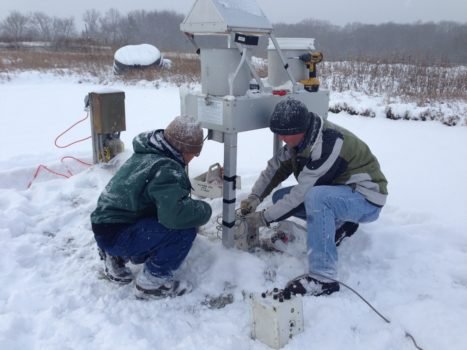Mercury: Toxic and Ubiquitous but Decreasing
Mercury is a toxic volatile metal that is is released into the atmosphere when coal is burned. It can be transported long distances before it is deposited to the earth’s surface. When ingested in its most toxic form, it has devastating neurological effects.
Mercury Deposition in the Great Lakes Region: Technical Report
In 2023, Dr. Angie Dickens, the LADCO Data Scientist, analyzed mercury deposition and atmospheric concentration data in the LADCO region. She presents and interprets these results in a technical report
Overview of the report: This report examines the amounts and trends in wet and dry (litterfall) deposition of mercury in the Great Lakes region, along with the limited records of mercury concentrations in the atmosphere in this region. These records derive from data collected as part of the National Atmospheric Deposition Program (NADP). This report draws on findings from published research studies to interpret the trends.
Sources, Effects, Measurement
Mercury (Hg) is a toxic, persistent air pollutant originating largely from human activities. Because it is persistent, it can travel long distances through the atmosphere before it is ultimately deposited to land and water surfaces. Once deposited, elemental Hg is converted to organic methylmercury (MeHg) in ecosystems where it accumulates and concentrates in food webs so that upper level consumers, such as humans and wildlife consuming fish, can be exposed through their diets to potentially harmful MeHg concentrations. Fetuses, infants, and children are most at risk. Health effects from mercury exposure include an array of neurological development deficits including impacts on cognitive thinking, memory, attention, language, and fine motor and visual spatial skills.
Scientists predict that reductions in Hg emissions will lead to decreased wet and dry atmospheric deposition and to lower ecosystem MeHg concentrations. In the US, regulations of many Hg emissions sources aim to limit releases to the air with the goal of protecting human health and restoring ecosystems.
Monitoring atmospheric Hg wet and dry deposition is a necessary complement to regulation of Hg emissions to the air. The network of mercury monitors is sparse, but analysis of trends over the last 15 years indicates declining concentrations in mercury wet deposition in the LADCO region. These declines come as a result of shifting away from coal and major legislation to control mercury emissions from large sources. Most LADCO states operate monitors that sample wet deposition of Hg as well as continuous monitors that can be used to estimate dry deposition. We continue to track trends and progress in Hg reductions across the region.



